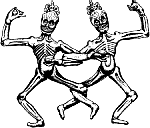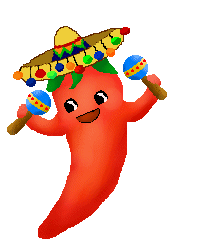
Dia
de los Muertos |
What is el Dia de los Muertos?
El Dia de los Muertos, or The Day of the Dead,
is one of the many fascinating celebrations that occur in Mexico. This
holiday reflects how Mexican culture accepts death as an essential part of
the cycle of life. Death on El Dia de los Muertos is joyfully celebrated
as families gather to honor and show respect for their loved ones who have
passed away. This holiday originated from the union of indigenous beliefs
of death and afterlife with the European rituals of All Saints' Day and
All Souls' Day.
There is the belief that during El Dia de los
Muertos, souls of the dead return to the earth for one day of the year.
The souls of children are said to arrive on October 31 and leave November
1, or All Saints' Day. The souls of the adults arrive on November 1 and
leave on November 2, All Souls' Day.
This celebration requires much preparation.
Families construct ofrendas (alters) to honor their loved ones. These
alters are decorated with candles, gifts, marigolds, banners, food, and
drinks. Tombs and graves in the cemeteries are cleaned and painted. A
special bread known as Pan de los Muertos (Bread of the Dead) is prepared
along with candies in the shape of skulls. Skeleton figures clothed in
modern and often comical attire are popular symbols of the holiday. El Dia
de los Muertos is a colorful and joyful celebration that connects the past
with the present. It reassures living Mexican people that when they too
have passed away, they will be remembered and celebrated. |
Objectives:
- Students will describe ways in which
people in the United States remember and honor the dead.
- After hearing the story Maria
Molina and the Days of the Dead, students will identify the similarities
and differences between El Dia de los Muertos , Memorial Day and Halloween
by completing a chart in cooperative groups.
- Students will identify the important role
food can play in social and religious events.
- Students will explain the specific role
of Pan de los Muertos to the El Dia de los Muertos celebration.
- Students will demonstrate knowledge of
fractions and measurement by following a recipe for Pan de los
Muertos.
- Students will work cooperatively to
prepare Pan de los Muertos and Mexican hot chocolate.
Time Required:
5 days
Vocabulary:
Vocabulario
for Dia de los Muertos
Materials:
Procedures:
- Ask students how people in America
remember their loved ones who have passed away. Encourage students to think
of some characteristics of American customs associated with remembering the
dead.(Example: Memorial Day) List student responses on the chalk board.
- Explain to students that the ways in
which people bury and remember their dead say much about the peoples’
beliefs, culture, and customs. Different societies deal with death in many
different ways. Explain to the students that they are going to hear a story
about a family from Mexico and a special way in which they remember their
dead.
- Ask students to point out Mexico on the world
map.
- Read the book Maria
Molina and the Days of the Dead. Give students a brief introduction to
the story before you read. Explain to the students what El Dia de los
Muertos festival is. Write the name on the board for students to see.
- As a motivation for the story, ask each
student to be thinking of the questions: How do Maria’s experiences in
Mexico with El Dia de los Muertos differ from her experiences with
Halloween? How does the way Maria’s family honor their dead differ from
the way the American culture honors their dead? Point out critical
attributes of El Dia de los Muertos as you read. Show illustrations to
students as you read. Clarify Spanish vocabulary used in the story.
- When finished with story, hand out one
chart worksheet to groups of four students. Allow the students ten minutes
to work with their group to fill out their chart highlighting the
similarities and differences between El Dia de los Muertos , Halloween, and
Memorial Day. Encourage the students to be thinking of the meaning of each
holiday as they fill out the chart.
- Have students share their comparisons
with the class. As students provide their comparisons, fill out a large
class chart on the chalkboard. Discuss the students’ comparisons.
Emphasize to the students that although Halloween and the El Dia de los
Muertos festival occur at the same time of the year, they are actually very
different holidays with very different purposes. They might be alike in
terms of food and visual images, but not in meaning. Explain to students
that although celebrated in many different ways, El Dia de los Muertos is
most like our Memorial Day in meaning.
Evaluation:
- Were students able to describe ways in
which people of the United States remember their dead?
- After hearing the story Maria Molina and
the Days of the Dead, were the students able to identify the similarities
and differences between El Dia de los Muertos , Halloween, and Memorial Day
by cooperatively filling out the chart provided in groups?
Extension Activities:
- Students can be given a vocabulary search
using the Spanish words related to the El Dia de los Muertos festival.
Students should be given opportunity to practice saying the words aloud.
- Prepare Pan
de los Muerto and Hot Chocolate.
Home Learning:
Students can be given a scavenger
hunt search using the many websites available on El Dia de los Muertos. Five
can be bookmarked for the students to use to find the answers to clues given on
terms, concepts, or characteristics on the festival. Students can be encouraged
to find one more website on their own.
Dia
de los Muertos Concentration Game

Home |